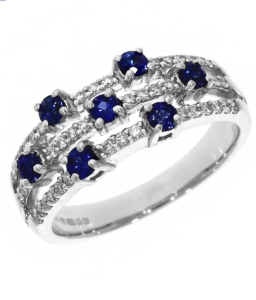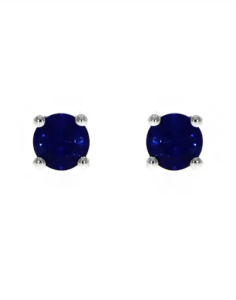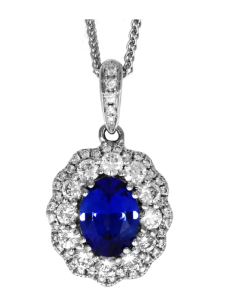September is the month of the sapphire. Desirable due to its beautiful colour, durability and lustre, sapphires have long been associated with royalty and have been popular since the Middle Ages. Today, most natural sapphires undergo a heat treatment process in order to improve their colour and clarity, which also helps to protect them against scratching. Untreated gems are rare and incredibly valuable.
While sapphire usually refers to the rich blue variety of the mineral corundum, this stone can occur in many shades, from pale pink and colourless to orange and green; the exception is red, as that would earn this royal gem the classification of ruby.
The colour of a sapphire typically determines its price, with the highest valued gems possessing a rich, vividly blue hue.
Properties of the Sapphire
The beautiful September birthstone is desired by many due to its superb properties that make any piece of jewellery high value:
Colour – The most valued hue is the rich cornflower blue that is most commonly associated with this gem. Different colours are caused by impurities in the gem; yellow sapphires contain ferric iron, blue sapphires iron and titanium, and colourless sapphires have no contaminants, for example. Secondary hues of green or grey can diminish the value of a sapphire. There is also a rare variety of sapphire that exhibits different colours in different lights; this colour-changing gemstone can show hues of blue in daylight and hues of red under incandescent light.
contain ferric iron, blue sapphires iron and titanium, and colourless sapphires have no contaminants, for example. Secondary hues of green or grey can diminish the value of a sapphire. There is also a rare variety of sapphire that exhibits different colours in different lights; this colour-changing gemstone can show hues of blue in daylight and hues of red under incandescent light.
Asterism – This is a star-like pattern on a cabochon-cut stone. It occurs when the sapphire is examined in direct sunlight or with intense light and results from needle-like inclusions of rutile or hematite.
Clarity – Blue sapphires tend to have better clarity than rubies, but they also often possess long, thin inclusions called ‘silk’. These defects can sometimes devalue gemstones, although they can also increase the value of sapphires that exhibit asterism.
Carat – Sapphires range in size and can have a varying degree of carats. A large majority of commercial-quality sapphires weigh less than five carats, with 2-carat sapphires being fairly common. Sapphires that weigh up to 10 carats can be found in a variety of colours.
Hardness – Sapphires are one of the most durable naturally-occurring elements in the entire world. These gems score a 9.0 on the Mohs scale of hardness and can only be scratched by a diamond, making them fantastic stones for everyday jewellery, such as engagement rings. This hardness also makes the sapphire incredibly useful for watchmaking, with many luxury timepieces featuring a sapphire crystal case.
Image: 18ct White Gold Sapphire and Diamond Dress Ring
Sapphires at Banks Lyon
 The sapphire is amongst the most prized and cherished of gems, and not just by royals. On the contrary, sapphires are often the gem of choice when it comes to engagement rings – it’s also the commemoration stone for the 5th and the 45th wedding anniversaries, so sapphire jewellery is the perfect anniversary gift for your beloved.
The sapphire is amongst the most prized and cherished of gems, and not just by royals. On the contrary, sapphires are often the gem of choice when it comes to engagement rings – it’s also the commemoration stone for the 5th and the 45th wedding anniversaries, so sapphire jewellery is the perfect anniversary gift for your beloved.
Luxury, elegance and beauty – the sapphire is a lovely gem that can complement any wardrobe, be it as a ring, necklace, bracelet or earrings.
Image: 18ct White Gold 0.60ct Sapphire Stud Earrings
Famous Sapphires Around the World
The superb sapphire has been treasured and desired for thousands of years, from Ancient Rome to modern times. Its beauty and sophistication are deeply desired by many around the world, including royalty, and they’ve long been associated with wisdom and divinity. Some of the most famous sapphires include:
- Star of Adam – The world’s largest blue star sapphire; this oval-shaped gemstone weighs 1404.49 carats and exhibits asterism. It was found in Ratnapura (nicknamed ‘city of
 gems’), Sri Lanka in 2015, and its size is due to continuous but slow changes in temperature and pressure over millions of years. This gem was valued at over £232 million.
gems’), Sri Lanka in 2015, and its size is due to continuous but slow changes in temperature and pressure over millions of years. This gem was valued at over £232 million. - Black Star of Queensland – Previously the largest gem-quality star sapphire ever found before the discovery of the Star of Adam, the Black Star of Queensland was found in Australia and weighs 733 carats. This black sapphire was discovered by Roy Spencer, a 12-year old boy, in the 1930s.
- Logan Sapphire – This 422.99-carat gem is one of the largest faceted gem-quality blue sapphires in the world. It’s a flawless cushion-cut sapphire with a rich blue colour that has been set in a brooch surrounded by 20 round brilliant-cut diamonds (which weigh, in total, 16 carats). This beautiful gem can be found in the National Museum of Natural History in Washington, DC.
- Hall Sapphire and Diamond Necklace – This piece is on display alongside the Logan Sapphire and is a gorgeous necklace with 36 matched sapphires from Sri Lanka, totalling 195 carats and cut into several different shapes, from pear to round and cushion. These gems are surrounded by 435 brilliant-cut diamonds that total 83.75 carats.
- Bismarck Sapphire Necklace – Also on display in the National Museum of Natural History in Washington, DC, alongside the Logan Sapphire and the Hall Sapphire and Diamond Necklace, is the Bismarck Sapphire Necklace. It was designed by Cartier in 1935 and possesses a 98.56-carat table-cut sapphire mined in Myanmar.
- Edward’s Sapphire – This octagonal, rose-cut sapphire is part of the British Crown Jewels and is thought to have been in the coronation ring of Edward the Confessor in 1042. The sapphire was added to the Imperial State Crown by Queen Victoria and is now on display with the other Crown Jewels in the Tower of London.
- Lady Diana’s Sapphire – One of the world’s most famous royal sapphires, the engagement ring gifted to Lady Diana Spencer in 1981 features a stunning 12-carat oval blue Ceylon sapphire surrounded by 14 solitaire diamonds. It was designed by then crown jeweller Garrard & Co, and its estimated value in 2016 was of £308,000. The ring is now worn by Catherine, Duchess of Cambridge.
Image: 18ct White Gold Sapphire And Diamond Halo Pendant
We have a vast range of birthstone jewellery at our Lancaster and Kendal stores that make wonderful gifts to be treasured forever. You can also check out our birthstone jewellery brochure for information on the stunning pieces you can find at Banks Lyon.